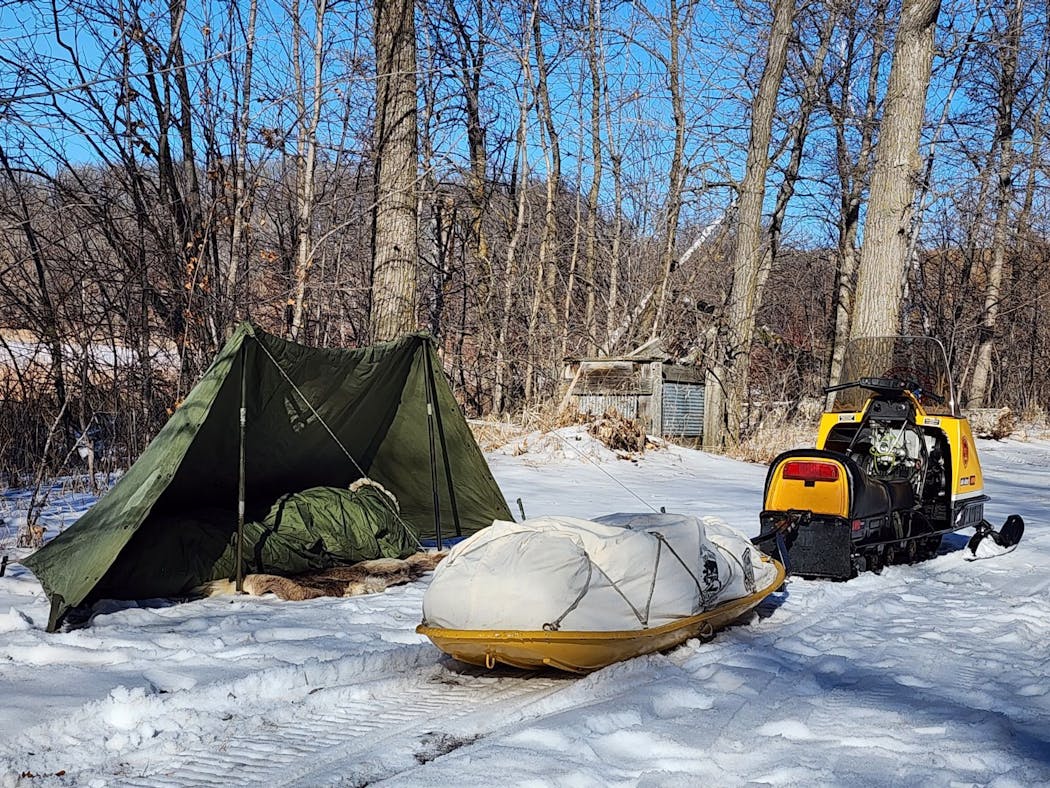A lot of old stuff can be bought on eBay.
A pair of 1936 Swedish Arctic boots? If you can find a pair in your size, go ahead, bid on them.
Or make an offer on a 1948 British Arctic mountain tent. Or a 1950 U.S. Army parka.
Then again, those and other pieces of outdoor gear dating to bygone eras might already have been purchased by Lance Woods and shipped to his home in Dent, Minn., population 170 and located about halfway between Fergus Falls and Detroit Lakes.
Outfitting himself with equipment that in its entirety harkens to decades long past, Woods, 62, is leaving for Alaska this week. Appropriately, given the vintage nature of his supplies, he'll have a 1973 snowmobile in tow.
Originally propelled by a 250cc engine, Woods' Ski-Doo Elan has been beefed up and now sports a 294cc power plant. He'll need all of that muscle when, in a couple of weeks, he attempts to cross Alaska's famous 1,000-mile-long Iditarod Trail.
"I figured if I'm going to take an old snowmobile, I might as well take all vintage equipment," Woods said.
This includes a single-burner stove for cooking, an old pair of U.S. Air Force flight pants and a 1960 union suit, or long johns — in red, of course — made by L.L. Bean.
Woods will angle onto the Iditarod Trail five days before sled-dog racers and their teams depart from Anchorage on the same route. The fastest mushers will reach the race's endpoint in Nome, Alaska, in about eight days, and Woods, whose journey is slated to take two weeks, expects to be passed by some competitors en route.
"Crossing the Alaska Range is what will slow me up," he said. "The sled I'll be pulling behind my snowmobile will be too heavy to pull up the mountains in one trip, so I'll have to unload some gear each time and make several trips."
In the sled will be about 20 pounds of spare snowmobile parts.
"I've rebuilt the snowmobile from the ground up with new parts, or if I couldn't find new parts, with parts I took from other machines," he said.
Nighttime temperatures en route could dip to minus-30 or colder, but Woods hopes to be cozy inside a 1953 Casualty sleeping bag ($375 to $425 online), which the Army distributed during the Korean War to keep injured troops warm.
Woods has taken three previous trips on the Iditarod Trail, each by himself. Two were by snowmobile (though on newer models), and one was on skis.
"The time I skied the Iditarod I made it 400 miles in six weeks, but by then, there was too much water overflowing on the river ice that I was crossing that I couldn't go any further," he said.
No stranger to Alaska, in the mid-1980s, Woods snowmobiled to the 49th state from his hometown, and in 1997, over three years, he snowmobiled from James Bay to Hudson Bay and Baffin Island in Nunavut, Canada.
"I did that on a Yamaha Bravo 250," he said, "camping along the way."
And last summer, Woods floated a 16-foot inflatable raft 1,600 miles down the Yukon River, from Whitehorse, Yukon, in Canada, to Russian Mission, Alaska. He had no problem with bears during the two-month trip, he said, but landed very few fish due to low salmon populations and cloudy river water.
"I got resupplied in various villages along the way," he said.
Woods hopes his vintage snowmobile adventure will call attention to the importance of preserving Alaska's Tongass National Forest.
Famous for its vast stands of western hemlock, red and yellow cedar, and Sitka spruce — some 800 years old and 200-feet tall — the Tongass is the world's largest intact temperate rainforest and is home to bald eagles, black and brown bears, Alexander Archipelago wolves and all five species of Pacific salmon.
Though last year the Biden administration reinstated a timber-cutting ban and most types of road building in 9 million acres of the forest, threats still remain, Woods said.
"Keeping roads out of the Tongass to protect salmon and wildlife and to reduce pollution is important," he said.
More immediately, Woods hopes to keep his snowmobile intact on the Iditarod Trail — thus the spare parts — and his toes warm in his old-timer boots.
The trip's biggest obstacle, he said, might be moose.
"It depends how deep the snow is, but if it's deep alongside the trail, a moose won't step aside because he or she can't get out of deep snow," Woods said. "They will charge people, so if you meet one on the trail, the best thing to do is to ease the moose down the trail to a turnout point, where you can get by."
Woods is confident he'll reach Nome — though he won't arrive without some aches and pains.
"Old snowmobiles are terribly uncomfortable and have virtually no suspensions," he said. "You can't sit down on them. I'll kneel all the way."

Anderson: Building a new Waterville fish hatchery will help shorten the time between bites

Anderson: Trailblazing sonar will be in thousands of boats for opener

Anderson: Celebrate Earth Day by rekindling real connection to nature
Anderson: Anglers protesting tough new Mille Lacs rules are wrong





